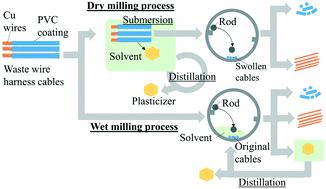当前位置:
X-MOL 学术
›
React. Chem. Eng.
›
论文详情
Our official English website, www.x-mol.net, welcomes your
feedback! (Note: you will need to create a separate account there.)
Highly efficient recovery of high-purity Cu, PVC, and phthalate plasticizer from waste wire harnesses through PVC swelling and rod milling
Reaction Chemistry & Engineering ( IF 3.4 ) Pub Date : 2020-08-07 , DOI: 10.1039/d0re00303d Harendra Kumar 1, 2, 3, 4 , Shogo Kumagai 1, 2, 3, 4 , Tomohito Kameda 1, 2, 3, 4 , Yuko Saito 1, 2, 3, 4 , Toshiaki Yoshioka 1, 2, 3, 4
Reaction Chemistry & Engineering ( IF 3.4 ) Pub Date : 2020-08-07 , DOI: 10.1039/d0re00303d Harendra Kumar 1, 2, 3, 4 , Shogo Kumagai 1, 2, 3, 4 , Tomohito Kameda 1, 2, 3, 4 , Yuko Saito 1, 2, 3, 4 , Toshiaki Yoshioka 1, 2, 3, 4
Affiliation

|
Novel methods for recycling waste wire harnesses, namely, dry rod milling (which involves the swelling of the cables followed by milling) and wet rod milling (which involves the simultaneous swelling and milling of the cables), were developed for the simultaneous recovery of the Cu wires, polyvinyl chloride (PVC) coatings, and phthalate plasticizer in high purity. The swelling of the PVC coatings facilitated the separation of the coatings from the Cu wires at moderate rod milling speeds and allowed for the extraction of the plasticizer. n-Butyl acetate was used as the swelling solvent and resulted in a sufficient degree of swelling (the volume increased to ∼3.5 times that of the original cables), thus allowing for the quantitative extraction of the plasticizer, which was diisononyl phthalate (DINP). The complete stripping of the PVC coatings and Cu wires from 20 cm-long cables could be performed within 60 min by both dry and wet milling at a low rotation speed (15 rpm). Furthermore, more than 90 wt% of the Cu wires longer than 10 cm could be recovered for subsequent Cu refining. The used n-butyl acetate was regenerated by distillation and exhibited PVC swelling properties comparable with those in the fresh state. Thus, the developed methods allow for the successful quantitative recovery of high-purity Cu, PVC, and DINP without requiring any of the complex multistep physical separation processes involved in the conventional granulation technique for the recycling of waste wire harnesses.
中文翻译:

通过PVC溶胀和棒磨从废线束中高效回收高纯度的Cu,PVC和邻苯二甲酸酯增塑剂
为了回收废旧线束,开发了新的回收废线束的方法,即干杆铣削(先将电缆溶胀,然后进行铣削)和湿杆铣削(先将电缆溶胀和铣削),然后再进行回收。铜线,高纯度的聚氯乙烯(PVC)涂层和邻苯二甲酸酯增塑剂。PVC涂层的溶胀促进了在中等棒磨速度下将涂层从铜线中分离出来,并允许提取增塑剂。ñ-乙酸丁酯用作溶胀溶剂,并产生足够的溶胀度(体积增加到原始电缆的约3.5倍),因此可以定量提取增塑剂,即邻苯二甲酸二异壬酯(DINP)。通过以低转速(15 rpm)进行干磨和湿磨,可以在60分钟内完成从20 cm长的电缆上完全剥落PVC涂层和Cu电线。此外,可以回收超过90wt%的长于10cm的Cu线,用于随后的Cu精炼。所使用的ñ乙酸丁酯通过蒸馏再生,并显示出与新鲜状态相当的PVC溶胀性能。因此,所开发的方法可以成功地定量回收高纯度的Cu,PVC和DINP,而无需任何常规造粒技术中涉及的复杂的多步物理分离工艺来回收废线束。
更新日期:2020-08-25
中文翻译:

通过PVC溶胀和棒磨从废线束中高效回收高纯度的Cu,PVC和邻苯二甲酸酯增塑剂
为了回收废旧线束,开发了新的回收废线束的方法,即干杆铣削(先将电缆溶胀,然后进行铣削)和湿杆铣削(先将电缆溶胀和铣削),然后再进行回收。铜线,高纯度的聚氯乙烯(PVC)涂层和邻苯二甲酸酯增塑剂。PVC涂层的溶胀促进了在中等棒磨速度下将涂层从铜线中分离出来,并允许提取增塑剂。ñ-乙酸丁酯用作溶胀溶剂,并产生足够的溶胀度(体积增加到原始电缆的约3.5倍),因此可以定量提取增塑剂,即邻苯二甲酸二异壬酯(DINP)。通过以低转速(15 rpm)进行干磨和湿磨,可以在60分钟内完成从20 cm长的电缆上完全剥落PVC涂层和Cu电线。此外,可以回收超过90wt%的长于10cm的Cu线,用于随后的Cu精炼。所使用的ñ乙酸丁酯通过蒸馏再生,并显示出与新鲜状态相当的PVC溶胀性能。因此,所开发的方法可以成功地定量回收高纯度的Cu,PVC和DINP,而无需任何常规造粒技术中涉及的复杂的多步物理分离工艺来回收废线束。











































 京公网安备 11010802027423号
京公网安备 11010802027423号